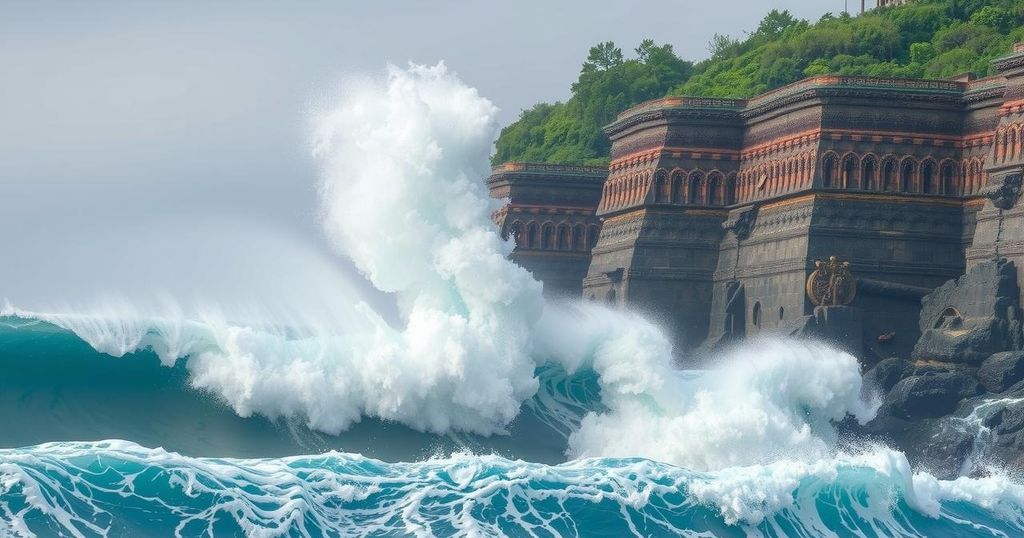Severe Waves Devastate Ecuador and Peru’s Coasts, Causing Port Closures and Fatalities

Ecuador and Peru are experiencing extreme wave conditions, reaching heights of four meters, resulting in two confirmed deaths and multiple port closures. Authorities attribute these waves to climate change and have undertaken actions to mitigate risks to local communities, particularly fishermen severely affected by the disruptions. The phenomenon, which began on Christmas Day, is expected to persist until January 1.
Large waves reaching heights of up to four meters have been relentlessly battering the coastlines of Ecuador and Peru, leading to the closure of numerous ports and resulting in the unfortunate deaths of at least two individuals, as reported on Sunday. Jorge Carillo, Ecuador’s secretary for risk management, highlighted the severity of the situation during a media briefing, indicating that this “extreme event” has the potential to recur in the future. The casualties, both recorded in Manta, Ecuador, exemplify the dire consequences of these climatic disturbances.
In Peru, the situation has prompted near-total port closures due to the continued assault of the waves. According to Enrique Varea, head of the naval Oceanographic Department, while the intense wave conditions are expected to persist for several days, a slight moderation is anticipated by Monday, with a gradual return to normalcy expected in early January. Climate change has been identified as a contributing factor to these abnormal wave patterns, as noted by Larry Linch, head of the Civil Defense unit in Callao, Peru.
Local media have broadcasted images depicting submerged public squares and damaged jetties in various regions of Peru, forcing residents to seek refuge in safer areas. The waves’ origins have been attributed to winds across the ocean’s surface, as reported by the Peruvian navy. Consequently, officials have closed many beaches along central and northern coastlines to protect public safety, while local fishermen have suffered significant losses, with one stating, “We need help from authorities. Here, we’ve lost some 100 boats.” So far, thirty-one fishermen stranded amid the waves were successfully rescued, while reports indicated that approximately 180 others remained at sea.
Particularly noteworthy is the impact in Callao, located near Lima and home to the largest port in Peru, where numerous beaches have been closed and fishing boats have been barred from leaving port. Mayor Roberto Carrillo Zavala addressed the situation, stating, “There is a major problem,” following an aerial assessment of the damage with Minister of Defense Walter Astudillo Chavez. The phenomenon, which commenced on Christmas Day, is predicted to continue until January 1, according to Peru’s National Emergency Operations Center.
The coastal regions of Ecuador and Peru are currently facing an intensification of wave activity, with significant implications for safety, commerce, and local economies. The reported wave heights of up to four meters have not only disrupted maritime activities but have also contributed to the tragic loss of life, highlighting the perilous nature of extreme weather events. These conditions are symptomatic of broader climatic changes impacting oceanographic patterns in the Pacific region, exacerbated by anthropogenic influences like climate change. Insufficient preparedness and response measures further complicate recovery efforts for local communities that rely significantly on fishing and maritime tourism. As climate irregularities become more prevalent, understanding the specific mechanisms and patterns driving such phenomena will be critical in developing more effective management and mitigation strategies to safeguard coastal populations in the future.
In summary, the severe wave conditions impacting Ecuador and Peru have resulted in significant maritime disruption, loss of life, and extensive damage to local economies, particularly for fishermen who reportedly lost around 100 boats due to the heightened waves. With authorities predicting continued hazardous conditions, it is imperative for relief efforts and precautionary measures to be swiftly implemented. Overall, this event underscores the urgent need to address climate change’s contributory role in exacerbating such extreme weather occurrences, marking a critical juncture for coastal communities affected by these ongoing challenges.
Original Source: www.voanews.com








